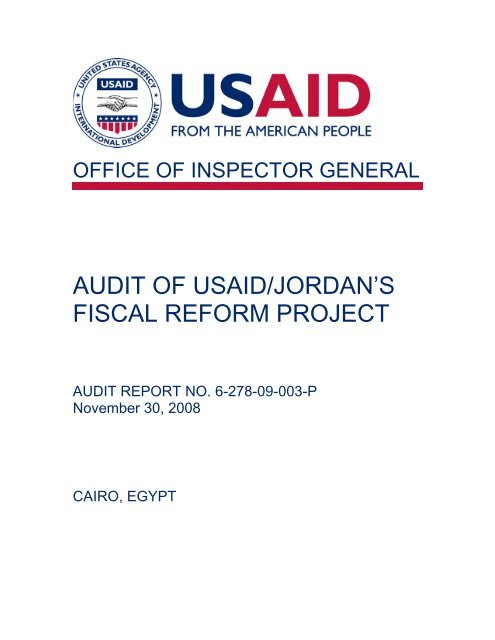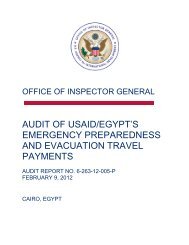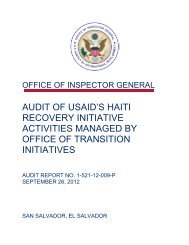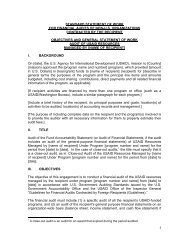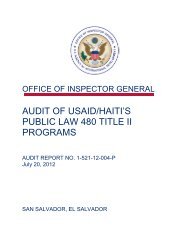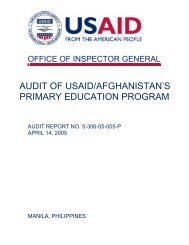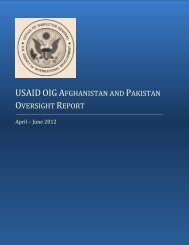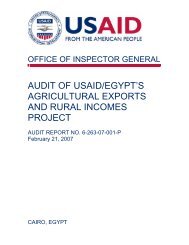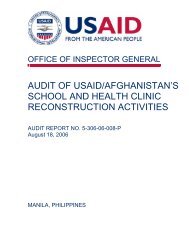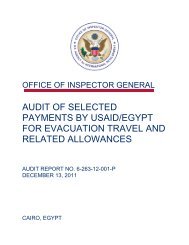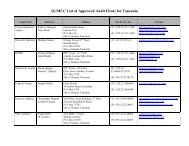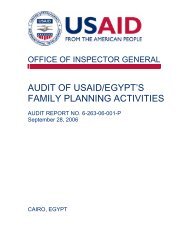Audit of USAID/Jordan's Fiscal Reform Project - US Agency For ...
Audit of USAID/Jordan's Fiscal Reform Project - US Agency For ...
Audit of USAID/Jordan's Fiscal Reform Project - US Agency For ...
You also want an ePaper? Increase the reach of your titles
YUMPU automatically turns print PDFs into web optimized ePapers that Google loves.
OFFICE OF INSPECTOR GENERALAUDIT OF <strong><strong>US</strong>AID</strong>/JORDAN’S FISCAL REFORM PROJECT AUDIT REPORT NO. 6-278-09-003-PNovember 30, 2008CAIRO, EGYPT
Office <strong>of</strong> Inspector GeneralNovember 30, 2008MEMORANDUMTO:FROM:SUBJECT:<strong><strong>US</strong>AID</strong>/Jordan Director, Jay KnottRegional Inspector General/Cairo, Lloyd J. Miller /s/<strong>Audit</strong> <strong>of</strong> <strong><strong>US</strong>AID</strong>/Jordan’s <strong>Fiscal</strong> <strong>Reform</strong> <strong>Project</strong>(Report No. 6-278-09-003-P)This memorandum transmits our final report on the subject audit. We have consideredyour comments on the draft report and have included your responses in appendix II.The report contains three recommendations intended to improve the implementation <strong>of</strong><strong><strong>US</strong>AID</strong>/Jordan’s fiscal reform project. Based on your comments and the documentationprovided, we consider a management decision has been made and final action has beentaken for recommendation no. 1. Management decisions for recommendations nos. 2and 3 will be considered to have been made when the <strong><strong>US</strong>AID</strong>/Jordan’s ContractingOfficer determines the allowability <strong>of</strong> questioned costs.Thank you for the cooperation and courtesy extended to the audit team during this audit.
CONTENTS Summary <strong>of</strong> Results ....................................................................................................... 1 Background ..................................................................................................................... 3 <strong>Audit</strong> Objective................................................................................................................ 3 <strong>Audit</strong> Findings................................................................................................................. 4 Performance Monitoring and Evaluation Plan Needs Updating .................................. 5 Questioned Costs Should Be Reviewed…………....................................................... 7 Management Controls Should Be Strengthened………… .......................................... 9 Evaluation <strong>of</strong> Management Comments ....................................................................... 11 Appendix I—Scope and Methodology......................................................................... 12 Appendix II—Management Comments........................................................................ 14 Appendix III—Achieved and Planned Results............................................................ 16 Appendix IV—Summary <strong>of</strong> Contractor Questioned Costs........................................ 19
SUMMARY OF RESULTS Despite a notable growth <strong>of</strong> Jordan’s gross domestic product by 7.5 percent in 2004, theamount <strong>of</strong> tax revenues from personal incomes, sales, and corporations as a percentage<strong>of</strong> overall revenues has not increased. To improve the efficiency and effectiveness <strong>of</strong>Jordan’s fiscal system, on May 25, 2006, <strong><strong>US</strong>AID</strong>/Jordan awarded BearingPoint, Inc., a$14 million contract to provide technical assistance to the Government <strong>of</strong> Jordan in thearea <strong>of</strong> fiscal policy. The 3-year project included activities in four areas—tax policy, taxadministration, budget management, and a public awareness campaign. (See page 4)The Regional Inspector General/Cairo performed this audit to determine whether<strong><strong>US</strong>AID</strong>/Jordan’s <strong>Fiscal</strong> <strong>Reform</strong> <strong>Project</strong> achieved planned results and what the impacthas been (see page 3). At the halfway point <strong>of</strong> the project, as <strong>of</strong> November 2007,<strong><strong>US</strong>AID</strong>/Jordan’s <strong>Fiscal</strong> <strong>Reform</strong> <strong>Project</strong> had achieved planned results in its tax policy andbudget management activities and had not achieved planned results in its taxadministration and public awareness activities. Overall, the project had achieved theplanned results for 31 <strong>of</strong> 50 performance indicators. (See page 4)Overall, the impact <strong>of</strong> the <strong>Fiscal</strong> <strong>Reform</strong> <strong>Project</strong> fell short <strong>of</strong> expectations for some <strong>of</strong> itsgoals at the halfway point <strong>of</strong> the project. On a positive note, the tax policy activitiesgenerated a series <strong>of</strong> analyses for decision-makers within the Government <strong>of</strong> Jordan,including a synthesis <strong>of</strong> all tax legislation and tax laws that were in use. However, theGovernment <strong>of</strong> Jordan has not yet implemented a new comprehensive tax code asrecommended by the project. Budget management activities produced a resultsorientedbudgeting capacity for the Government <strong>of</strong> Jordan for the first time, and allbudget activities are now tied to budget classifications. The audit identified the followingthree issues requiring <strong><strong>US</strong>AID</strong>/Jordan’s management attention. (See page 4)First, the contractor’s performance monitoring and evaluation plan needs updating. TheJordan’s <strong>Fiscal</strong> <strong>Reform</strong> <strong>Project</strong> contract required the contractor to update theperformance monitoring and evaluation plan each year. After the contractor prepared itsinitial performance monitoring and evaluation plan in November 2006, the contractor hadnot subsequently updated this plan, despite changing conditions including keyassumptions not being fulfilled, indicators not being completed, and missing baselinesand targets. In July 2008, the contractor submitted an updated performance monitoringand evaluation plan to <strong><strong>US</strong>AID</strong>/Jordan, which the mission had not approved at theconclusion <strong>of</strong> the audit work. (See page 5)Second, the contractor's invoices included questioned costs. According to the contractor,the invoice process allowed instances <strong>of</strong> duplicate uploads <strong>of</strong> charges into its accountingsystem. Consequently, in some instances, the contractor billed <strong><strong>US</strong>AID</strong>/Jordan for duplicatecharges. As a result, the audit identified total questioned costs <strong>of</strong> $41,639. (See page 7)Third, management controls should be strengthened to improve the accountability andeffectiveness <strong>of</strong> <strong><strong>US</strong>AID</strong>/Jordan’s programs. In one instance, the Ministry <strong>of</strong> Financerejected project deliverables because the contractor did not coordinate its work with theMinistry staff to determine specific needs or notify mission staff about communicationdifficulties. (See page 9)1
In its response to the draft report, <strong><strong>US</strong>AID</strong>/Jordan has taken corrective action andcompleted final actions for recommendation no. 1 and is currently assessing andreviewing information in regard to recommendations nos. 2 and 3. (See page 11)Management comments in their entirety are included in appendix II. (See pages 14-15)2
BACKGROUND Over the past several years, the objective <strong>of</strong> the Government <strong>of</strong> Jordan’s NationalAgenda has been to raise living standards over the medium term through accelerated,private sector-led growth and implementation <strong>of</strong> sound economic and fiscal policies. Inaddition, the Jordan National Agenda emphasized broadening the tax base to increaserevenue collection and establish a central results-oriented budget. Despite a notablegrowth <strong>of</strong> the country’s gross domestic product by 7.5 percent in 2004, the amount <strong>of</strong> taxrevenues from personal incomes, sales, and corporations as a percentage <strong>of</strong> overallrevenues had not increased.The Government <strong>of</strong> Jordan has been active recently in implementing a fiscal reformstrategy, mostly focused on improving the efficiency <strong>of</strong> the tax system. To improve theefficiency and effectiveness <strong>of</strong> Jordan’s fiscal system, <strong><strong>US</strong>AID</strong>/Jordan awardedBearingPoint task order number GEG-I-04-00004-00, a $14 million contract, on May 25,2006, to provide technical assistance to the Government <strong>of</strong> Jordan in the area <strong>of</strong> fiscalpolicy. The 3-year project included activities in four areas—tax policy, taxadministration, budget management, and a public awareness campaign. As <strong>of</strong>November 30, 2007, <strong><strong>US</strong>AID</strong>/Jordan had obligated $9.3 million and had disbursed $7.0million for the <strong>Fiscal</strong> <strong>Reform</strong> <strong>Project</strong>.At <strong><strong>US</strong>AID</strong>/Jordan, the Office <strong>of</strong> Economic Growth is responsible for the management the<strong>Fiscal</strong> <strong>Reform</strong> <strong>Project</strong>. The <strong>of</strong>fice used an indefinite quantity contract, which is anacquisition instrument that was pre-competed and awarded by <strong><strong>US</strong>AID</strong>/Washington. Anindefinite quantity contract is a centrally funded mechanism for worldwide use. Using anindefinite quantity contract, <strong><strong>US</strong>AID</strong>/Jordan awarded a task order under the indefinitequantity contract that included technical requirements for its fiscal reform activities.AUDIT OBJECTIVEThe audit was conducted as part <strong>of</strong> the Office <strong>of</strong> Inspector General’s audit plan for fiscalyear 2008 to answer the following question:• Has <strong><strong>US</strong>AID</strong>/Jordan’s <strong>Fiscal</strong> <strong>Reform</strong> <strong>Project</strong> achieved planned results and whathas been the impact?Appendix I contains a discussion <strong>of</strong> the audit’s scope and methodology.3
AUDIT FINDINGS At the halfway point <strong>of</strong> the project as <strong>of</strong> November 2007, <strong><strong>US</strong>AID</strong>/Jordan’s <strong>Fiscal</strong> <strong>Reform</strong><strong>Project</strong> had achieved planned results in its tax policy and budget management activitiesand had not achieved planned results in its tax administration and public awarenessactivities that represent 50 indicators in total. In particular, the mission had not achieved9 <strong>of</strong> its 14 tax administration indicators. (See appendix III for the status <strong>of</strong> individualperformance indicators).Within the tax policy area, the project achieved planned results for 11 <strong>of</strong> 12 performanceindicators. <strong>For</strong> example, the project established a tax policy unit, and this unit providedrecommendations for a new Jordanian tax code to the Director General <strong>of</strong> the Incomeand Sales Tax Division and the Minister <strong>of</strong> Finance within the Government <strong>of</strong> Jordan.The project also provided training sessions to government staff on various aspects <strong>of</strong> taxpolicy analyses.In the budget management area, the project achieved planned results for 14 <strong>of</strong> 17performance indicators. <strong>For</strong> example, budget management activities produced a resultsoriented budgeting capacity within the Government <strong>of</strong> Jordan, consisting <strong>of</strong> an integrateddatabase <strong>of</strong> funded investment projects. The project also delivered training programs toabout 450 Government <strong>of</strong> Jordan staff, covering areas such as budget preparation andbudget classification. This complimented work to complete chart <strong>of</strong> accounts structuresthat were consistent with international best practices. In addition, the project was ontrack to implement a government financial management information system.However, the project did not achieve planned results for 9 <strong>of</strong> 14 tax administrationperformance indicators. <strong>For</strong> example, six <strong>of</strong> the nine indicators were intended toautomate portions <strong>of</strong> the tax collection process, build internal audit capability, andimprove customer service. Although the activities include a nationwide customersatisfaction survey to be conducted for three <strong>of</strong> nine indicators, the contractor andmission <strong>of</strong>ficials agreed not to conduct the survey.Lastly, the project did not achieve planned results for 6 <strong>of</strong> 7 public awarenessperformance indicators. The project’s performance indicators were designed to primarilymeasure public contact with the Government’s Income and Sales Tax Division, includingthe number <strong>of</strong> businesses and other institutions requesting assistance and training; thenumber <strong>of</strong> telephone calls received by the Division, and the number <strong>of</strong> press releasesissued to promote public awareness on tax-related issues. <strong>For</strong> example, the taxadministration area <strong>of</strong> the project included some public awareness activities such aspromotions for the 2007 tax filing season and advertising materials that encouraged thepayment <strong>of</strong> income taxes. Although the project developed a strategy for acomprehensive public awareness campaign, the planned implementation <strong>of</strong> theseactivities was delayed because the Jordanian Parliament has not passed new taxlegislation.Overall, the impact <strong>of</strong> the <strong>Fiscal</strong> <strong>Reform</strong> <strong>Project</strong> fell short <strong>of</strong> expectations at the half-waypoint <strong>of</strong> the project; 31 <strong>of</strong> the planned results or 62 percent have been achieved. On apositive note, the tax policy activities generated a series <strong>of</strong> analyses for decision-makerswithin the Government <strong>of</strong> Jordan, including a synthesis <strong>of</strong> all tax legislation and tax laws4
that were in use. Although the project achieved some success, the Government <strong>of</strong>Jordan has not yet implemented a new comprehensive tax code as recommended bythe project. Budget management activities produced a results oriented budgetingcapacity for the Government <strong>of</strong> Jordan for the first time. In addition, all budget activitiesare now tied to budget classifications. As discussed in the following report sections, theaudit identified the following issues requiring <strong><strong>US</strong>AID</strong>/Jordan management attention.• Performance monitoring and evaluation plan needs updating.• Questioned costs should be reviewed.• Management controls should be strengthened.Performance Monitoring andEvaluation Plan Needs UpdatingSummary: The Jordan <strong>Fiscal</strong> <strong>Reform</strong> <strong>Project</strong> contract required that the performancemonitoring and evaluation plan be updated each year. Similarly, <strong>Agency</strong> guidancerequires a mission to monitor implementer output quality and timeliness. Although thecontractor prepared its initial performance monitoring and evaluation plan in November2006, the contractor has not subsequently updated this plan despite changing conditionsincluding key assumptions not being fulfilled, indicators not being completed, andmissing baselines and targets. According to the contractor, the delay was due to the latearrival <strong>of</strong> the contractor’s performance monitoring and evaluation consultant in Jordan.Consequently, the contractor and <strong><strong>US</strong>AID</strong>/Jordan did not adjust the project’s performancemeasures to address several challenges to fiscal reform in Jordan.<strong><strong>US</strong>AID</strong> Automated Directives System (ADS) 202.3.6, states that a mission’s cognizanttechnical <strong>of</strong>ficers and the strategic objective team are responsible for the major task <strong>of</strong>monitoring the quality and timeliness <strong>of</strong> outputs produced by implementing partners.The guidance also explains that delays in completing outputs, or problems in outputquality, provide an early warning that results may not be achieved as planned and thatearly action in response to such problems is essential in managing for results.Moreover, ADS 202.3.6.3 states that operating units must make adjustments whenconditions warrant. In addition to these requirements, the contract required BearingPointto develop a comprehensive monitoring and evaluation plan to measure programprogress and impact.BearingPoint prepared its initial performance monitoring and evaluation plan inNovember 2006. However, the contractor has not subsequently updated this plandespite changing conditions, including key assumptions not being fulfilled, indicators notbeing completed, and missing baselines and targets. In its performance monitoring andevaluation plan, the contractor identified a number <strong>of</strong> economic, political, andenvironmental handicaps to performance as critical assumptions to meeting targets. <strong>For</strong>example, the postponement <strong>of</strong> implementation <strong>of</strong> the new unified tax code and itspassage into a law by the Jordanian Government prevented full achievement <strong>of</strong> aplanned result for a public awareness campaign. Consequently, the Ministry <strong>of</strong> Financehas not been able to implement a public awareness campaign in this regard. Moreover,since the mission did not update its performance monitoring and evaluation plan, theindicators by which <strong><strong>US</strong>AID</strong>/Jordan used to measure its performance management woulderroneously indicate that it failed to achieve targets previously established in November2006.5
Automated Directives System 203.3.4.5 states that indicators “should includeperformance baselines and set performance targets that can optimistically butrealistically be achieved within the stated timeframe and with the available resources.”<strong>For</strong> example, <strong>of</strong> the seven performance indicators for public awareness, the contractorand <strong><strong>US</strong>AID</strong>/Jordan had not established baselines for 4 and had not determined targetsfor 3 performance indicators. Specifically, the performance indicator—“Number <strong>of</strong>businesses, associations, and institutions which requested assistance and training bythe Income and Sales Tax Division”—did not have either a baseline or a target tomeasure results. Another indicator—“Number <strong>of</strong> collateral produced to promote publicawareness on tax-related issues,”—also did not have either a baseline or a target. Afterbaselines are determined, targets are used to represent the expected level <strong>of</strong>achievement beyond the baselines within a given period <strong>of</strong> time. In tandem, baselinesand targets should monitor the progress <strong>of</strong> the project. Although <strong><strong>US</strong>AID</strong>/Jordan hadapproved the contractor’s initial performance monitoring and evaluation plan inNovember 2006, this plan had never been updated or approved to establish keyperformance measures that were initially missing.BearingPoint stated in its June 2007 annual report that the delay in updating theperformance monitoring and evaluation plan was attributable to <strong><strong>US</strong>AID</strong>/Jordan’sdevelopment <strong>of</strong> a new set <strong>of</strong> indicators for the mission’s operational plan. The August2007 annual work plan for the second year <strong>of</strong> operation did not contain an updatedperformance monitoring and evaluation plan although it was required by the contract.That annual work plan indicated that the update <strong>of</strong> the performance monitoring plan wasdeferred until the arrival <strong>of</strong> a performance monitoring and evaluation specialist, whichwas scheduled for November 2007. As <strong>of</strong> January 2008, the contractor had still notupdated the performance monitoring and evaluation plan. In February 2008, thecontractor proposed a planning session during the spring <strong>of</strong> 2008 for the update. In July2008, the contractor submitted a performance monitoring and evaluation plan to<strong><strong>US</strong>AID</strong>/Jordan, which the mission had not yet approved at the conclusion <strong>of</strong> the auditwork.The updated performance monitoring and evaluation plan for the second year <strong>of</strong> theproject was due in June 2007. However, the contractor had not updated the plan byNovember 30, 2007. Subsequently, over than a year from the due date, and specificallyin July 2008, the contractor issued an updated plan, which the Mission had not approvedat the conclusion <strong>of</strong> the audit work. As a consequence <strong>of</strong> the delay in updating theperformance monitoring plan, the contractor will need to revise indicators and establishmissing baselines and targets for the final year <strong>of</strong> the project. Because the latemeasuring <strong>of</strong> progress puts the results <strong>of</strong> the Jordan <strong>Fiscal</strong> <strong>Reform</strong> <strong>Project</strong> at risk <strong>of</strong> notbeing completed as planned and can cause the inefficient use <strong>of</strong> contract resources, thisaudit makes the following recommendation to <strong><strong>US</strong>AID</strong>/Jordan.Recommendation No. 1: We recommend that <strong><strong>US</strong>AID</strong>/Jordan direct thecontractor to update the performance monitoring and evaluation plan ontime for the final year <strong>of</strong> the project in accordance with the terms <strong>of</strong> thecontract.6
Questioned Costs Should Be ReviewedSummary: Federal Acquisition Regulation 31.201-2 sets the standards for theallowability <strong>of</strong> costs for contracts with commercial organizations. The contractor’sinvoices contained erroneous, unsupported, incomplete, and missing financial data. Theaudit identified questioned costs <strong>of</strong> $41,639; <strong>of</strong> that amount, the contractor has agreed torefund $25,132 to <strong><strong>US</strong>AID</strong>/Jordan. According to the contractor, the BearingPoint invoiceprocess allowed instances <strong>of</strong> duplicate uploads <strong>of</strong> charges into their accounting system.Subsequently, during <strong><strong>US</strong>AID</strong>/Jordan’s review <strong>of</strong> the contractor’s invoices, the missionstaff found a few instances where the contractor revised some <strong>of</strong> its invoices, but themission did not identify some duplicate charges. As a result, questioned costsunnecessarily have decreased available resources for other program activities.Federal Acquisition Regulation 31.201-2 sets the standards for the allowability <strong>of</strong> costsfor contracts with commercial organizations. According to the standards, a cost isallowable only when it complies with all requirements, including reasonableness,allocability, and the terms <strong>of</strong> the contract. Furthermore, section 31.201-2(d) <strong>of</strong> theFederal Acquisition Regulation states that “a contractor is responsible for accounting forcosts appropriately and for maintaining records, including supporting documentation,adequate to demonstrate that costs claimed have been incurred, are allocable to thecontract, and comply with applicable cost principles in this subpart and agencysupplements. The contracting <strong>of</strong>ficer may disallow all or part <strong>of</strong> a claimed cost that isinadequately supported.”Although the contractor’s invoices for the period from May 25, 2006, to November 30,2007, contained erroneous, unsupported, incomplete, and missing financial data,<strong><strong>US</strong>AID</strong>/Jordan paid the contractor for the amounts billed. According to the cognizanttechnical <strong>of</strong>ficer, as <strong>of</strong> November 2007, the contractor had billed <strong><strong>US</strong>AID</strong>/Jordan using 18invoices for approximately $7 million for project expenses. The cognizant technical<strong>of</strong>ficer reviewed the invoices to determine the propriety <strong>of</strong> the costs billed to<strong><strong>US</strong>AID</strong>/Jordan. To document the questioned costs, the cognizant technical <strong>of</strong>ficercontacted the contractor, either telephonically or in writing, to request clarification oradditional supporting documentation about the charges present for mission payment. Inmost instances, mission staff found the contractor charges to be valid. However, in afew instances, the contractor agreed to revise some <strong>of</strong> its invoices because <strong>of</strong> erroneouscharges identified by the cognizant technical <strong>of</strong>ficer.In addition to the cognizant technical <strong>of</strong>ficer’s review <strong>of</strong> the contractor’s invoices, theaudit identified additional errors on the invoices that provided inadequate explanations <strong>of</strong>costs claimed and missing dates for lodging and per diem. Of approximately $618,304in charges, the audit team identified questioned costs <strong>of</strong> $41,639, representingapproximately 7 percent <strong>of</strong> a subset <strong>of</strong> the total <strong>of</strong> invoices reviewed. As a result <strong>of</strong> thisaudit, the contractor has agreed to refund to <strong><strong>US</strong>AID</strong>/Jordan the amount <strong>of</strong> $25,132 <strong>of</strong> the$41,639 in identified questioned costs. (See appendix IV for details <strong>of</strong> the questionedcosts.) The $41,639 in questioned costs consisted <strong>of</strong> the following.• Duplicate and/or overcharges <strong>of</strong> travel and transportation costs <strong>of</strong> $19,110.• Duplicate and/or overcharges <strong>of</strong> allowances <strong>of</strong> $10,675.• Ineligible labor charges for consultants <strong>of</strong> $11,855.7
According to the contractor, BearingPoint’s invoice process allowed instances <strong>of</strong>duplicate uploads <strong>of</strong> charges into the accounting system. In some instances, thecontractor submitted invoices that contained duplicate project charges to <strong><strong>US</strong>AID</strong>/Jordan.The cognizant technical <strong>of</strong>ficer received and reviewed the contractor’s invoices monthlyas a part <strong>of</strong> the mission’s management review process. After this review, the cognizanttechnical <strong>of</strong>ficer forwarded the approved invoices to the mission’s financial management<strong>of</strong>fice for a secondary management review and validation before executing payments.During the audit, the <strong><strong>US</strong>AID</strong>/Jordan cognizant technical <strong>of</strong>ficer expressed concerns thatthe contractor invoices were ambiguous and difficult to understand, but the mission’scontracting <strong>of</strong>fice staff affirmed that the contractor prepared the invoices in accordancewith the reporting requirements <strong>of</strong> the indefinite quantity contract that was centrallyawarded by <strong><strong>US</strong>AID</strong>/Washington. According to the mission’s contracting <strong>of</strong>fice,<strong><strong>US</strong>AID</strong>/Jordan can not change the clauses that were place in the indefinite quantitycontract over the billing process; therefore, the mission was not allowed to require thecontractor to modify its billing system. Consequently, the contractor’s billing systemwould be consistent at each <strong><strong>US</strong>AID</strong> mission where it conducts work. Nevertheless, as aresult <strong>of</strong> this audit, a BearingPoint representative stated that the contractor institutedenhanced processes and quality control improvements to avoid duplicate uploads as <strong>of</strong>January 2008. The contractor reports that these corrective measures include (1) moretimely uploads <strong>of</strong> charges to avoid duplicate entries caused by initiating a corrective (andduplicate) upload when the original billing is not prepared in a timely manner,(2) validation <strong>of</strong> costs against submitted transactions, and (3) training for project staff toensure that all uploads and corrections are reviewed and validated. As a result <strong>of</strong> thesecorrective measures, the mission cognizant technical <strong>of</strong>ficer has noticed significantimprovement in the invoices reviewed.Management control activities associated with <strong><strong>US</strong>AID</strong> programs and operations must beeffective and efficient to achieve objectives. These control activities include reviews bymanagement <strong>of</strong> activities such as approvals, authorizations, verifications, andreconciliations. Each <strong><strong>US</strong>AID</strong> <strong>of</strong>fice has a critical role to ensure, among other things, thattransactions are allowable, reasonable, and properly supported. Since questioned costsunnecessarily decreased available resources for other program activities, this auditmakes the following recommendations to <strong><strong>US</strong>AID</strong>/Jordan:Recommendation No. 2: We recommend that the Contracting Officer,<strong><strong>US</strong>AID</strong>/Jordan, determine the allowability <strong>of</strong> the ineligible questionedcosts <strong>of</strong> $28,650 <strong>of</strong> duplicate and/or overcharges for travel, allowances,and labor claimed by the contractor for the period from May 25, 2006, toNovember 30, 2007, and recover any amounts determined to beunallowable.Recommendation No. 3: We recommend that the Contracting Officer,<strong><strong>US</strong>AID</strong>/Jordan, determine the allowability <strong>of</strong> the unsupported questionedcosts <strong>of</strong> $12,989 <strong>of</strong> duplicate and/or overcharges for travel andallowances claimed by the contractor for the period from May 25, 2006, toNovember 30, 2007, and recover any amounts determined to beunallowable.8
Management ControlsShould Be StrengthenedSummary: Automated Directives System 596, “Management’s Responsibility for InternalControl,” provides policy directives and required procedures to improve accountabilityand effectiveness <strong>of</strong> <strong><strong>US</strong>AID</strong> programs. At <strong><strong>US</strong>AID</strong>/Jordan, in one specific instance, fiscalreform activities included specific project deliverables that were rejected by Jordan’sMinistry <strong>of</strong> Finance. The Ministry rejected the project deliverables because thecontractor did not coordinate its work with the Ministry staff to determine specific needsor notify mission staff about communication difficulties. As <strong><strong>US</strong>AID</strong>’s technicalrepresentative, the cognizant technical <strong>of</strong>ficer shares responsibility in effective projectcommunication. Because <strong>of</strong> the lack <strong>of</strong> open and constant communication amongstakeholders, <strong><strong>US</strong>AID</strong>/Jordan did not maximize its use <strong>of</strong> project funds to ensure that itsfiscal reform activities were effective and efficient to achieve desired results.Automated Directives System 596.3.1c requires <strong><strong>US</strong>AID</strong> managers to, among otherthings, develop internal controls activities that would reasonably ensure that activitiesare effective and efficient. Such activities include establishment, and reviews <strong>of</strong>performance measures and indicators, and the proper execution <strong>of</strong> events.In July 2004, a joint World Bank/International Monetary Fund mission identified thefunctions <strong>of</strong> commitment control and cash management as being major deficiencieswhich needed to be addressed on a priority basis. In addition, the World Bankemphasized that management and control <strong>of</strong> expenditure commitments was essential forefficient and effective resource management; for monitoring <strong>of</strong> budgetary performance <strong>of</strong>ministries and departments; and for aggregate cash management by the Ministry <strong>of</strong>Finance.<strong><strong>US</strong>AID</strong>/Jordan incorporated the commitment control and cash management functionsinto the BearingPoint contract’s statement <strong>of</strong> work in May 2006. In part, the contractorwas to (1) perform assessments <strong>of</strong> and make recommendations to Jordan’s Ministry <strong>of</strong>Finance’s regarding its commitment control and cash management functions, and (2)develop a public awareness campaign that would help to inform the public aboutimpending changes in the tax system to increase compliance rates.During 2006, after the Ministry requested the assessments <strong>of</strong> its cash management andcommitment control activities, BearingPoint hired a team <strong>of</strong> two advisors for about threeweeks to perform the required assessments. Although the contractor performedassessments and submitted recommendations to the Ministry <strong>of</strong> Finance, the Ministryrejected the work products because the resulting work did not expand on previouslyconducted analyses on the cash management and commitment control functions.Although the Ministry rejected the work products, <strong><strong>US</strong>AID</strong>/Jordan paid the contractor$57,538 for these efforts because BearingPoint completed its assigned work andproduced an assessment with recommendations, as required.According to the cognizant technical <strong>of</strong>ficer, before the contractor began its work, theMinistry <strong>of</strong> Finance had conducted and nearly completed assessments <strong>of</strong> these tw<strong>of</strong>unctions, but needed technical assistance from BearingPoint. Despite BearingPoint’sunsuccessful attempts to contact Ministry <strong>of</strong>ficials for guidance and input, the contractordid not contact the mission staff to report any difficulties with communicating with9
Ministry <strong>of</strong>ficials. Ultimately, the contractor performed separate assessments withoutconsulting with the Ministry staff—which were ultimately rejected by Ministry <strong>of</strong> Finance<strong>of</strong>ficials.As a result <strong>of</strong> lessons learned, <strong><strong>US</strong>AID</strong>/Jordan began using a formal forum to increasecommunication and cooperation. <strong><strong>US</strong>AID</strong>/Jordan’s cognizant technical <strong>of</strong>ficeracknowledged that Mission staff typically do not “micro-manage” or manage thecontractor’s daily activities, but <strong>of</strong>ten work closely with the contractor and Ministry<strong>of</strong>ficials. Moreover, the BearingPoint Chief <strong>of</strong> Party also acknowledged that its team hadnot provided work products desired by the Ministry due to the lack <strong>of</strong> collaboration thecontractor and the Ministry. In this instance, a communication breakdown occurred thatnegatively impacted the project. To ensure open and on-going communication,<strong><strong>US</strong>AID</strong>/Jordan and the Ministry established a steering committee to meet monthly todiscuss project activities. The steering committee includes <strong>of</strong>ficials from theGovernment <strong>of</strong> Jordan, BearingPoint, and <strong><strong>US</strong>AID</strong>/Jordan.Since <strong><strong>US</strong>AID</strong> managers are the chief stewards <strong>of</strong> public resources, <strong>of</strong>ficials shouldreasonably ensure that project objectives are being achieved. As a consequence,<strong><strong>US</strong>AID</strong>/Jordan resources should be expended on project work products that are <strong>of</strong> valueto the mission and its stakeholders, as well as usable. Since <strong><strong>US</strong>AID</strong>/Jordan has takencorrective action to establish a steering committee to ensure project managementoversight <strong>of</strong> its ongoing activities, this audit is not making a recommendation at this time.10
EVALUATION OFMANAGEMENT COMMENTSIn its response to the draft report, <strong><strong>US</strong>AID</strong>/Jordan has taken corrective action andcompleted final actions for recommendation no. 1 and is currently assessing andreviewing information to make management decisions to address recommendations nos.2 and 3.In response to recommendation no. 1, <strong><strong>US</strong>AID</strong>/Jordan approved a monitoring andevaluation plan for its fiscal reform project activities in July 2008. Since the revisedperformance monitoring and evaluation plan covers the project until its completion inMay 2009, the Mission’s corrective action addresses the recommendation. Based onaction taken by the Mission, the audit team considers that both a management decisionand final action have been taken for the recommendation.With regard to recommendations no. 2 and 3, the Automated Directives System595.3.1.2a requires the Contract/Grant Officer to make a determination <strong>of</strong> allowability <strong>of</strong>questioned costs and to establish a target date for collection <strong>of</strong> the disallowed amounts.Accordingly, after the contracting <strong>of</strong>ficer has determined the allowability <strong>of</strong> thequestioned costs, the mission can request our acknowledgement <strong>of</strong> managementdecisions.Mission comments in their entirety are included in appendix II.11
APPENDIX I SCOPE AND METHODOLOGY ScopeThe Regional Inspector General’s Office in Cairo, Egypt, conducted this audit inaccordance with generally accepted government auditing standards. Those standardsrequire that we plan and perform the audit to obtain sufficient, appropriate evidence toprovide a reasonable basis for our findings and conclusions based on our auditobjective. We believe that the evidence obtained provides a reasonable basis for ourfindings and conclusions based on our audit objective. The purpose <strong>of</strong> the audit was todetermine whether the <strong><strong>US</strong>AID</strong>/Jordan <strong>Fiscal</strong> <strong>Reform</strong> <strong>Project</strong> achieved planned results andwhat has been the impact.On May 25, 2006, <strong><strong>US</strong>AID</strong>/Jordan awarded BearingPoint, Inc., contract numberGEG-I-04-0004-00, a $14 million time and materials, level <strong>of</strong> effort contract, to providetechnical assistance to the Government <strong>of</strong> Jordan to effect fiscal reform in the country’stax policy, budget management, and tax administration. The main recipient <strong>of</strong> thecontractor’s technical assistance was the Jordanian Ministry <strong>of</strong> Finance. The contractcovered a 3-year period ending in May 2009. As <strong>of</strong> November 30, 2007, the<strong><strong>US</strong>AID</strong>/Jordan had obligated $9.3 million and had disbursed $7.0 million for the <strong>Fiscal</strong><strong>Reform</strong> <strong>Project</strong>.We conducted our audit work from November 12, 2007, to June 24, 2008, at<strong><strong>US</strong>AID</strong>/Jordan and BearingPoint <strong>of</strong>fices in Amman, Jordan. We interviewed keyprogram staff at the <strong><strong>US</strong>AID</strong>/Jordan mission and BearingPoint as well as <strong>of</strong>ficials from theJordanian Ministry <strong>of</strong> Finance in Amman. We also reviewed relevant performance andfinancial documents.In conducting this audit, we examined the activities listed in the contractor’s annual workplan and all 50 corresponding indicators listed in the contractor’s performancemonitoring and evaluation plan. We obtained information as to whether the programachieved its planned results from the contractor’s headquarters in the Washington, DC,area as well as <strong><strong>US</strong>AID</strong>/Jordan’s technical <strong>of</strong>fice. To assess the project’s impact, weinterviewed Jordanian government <strong>of</strong>ficials, including the Minister <strong>of</strong> Finance and theDirector General <strong>of</strong> Jordan’s Budget Department.In addition, we examined significant mission management controls relating to the auditobjective, including the following:• Monitoring <strong>of</strong> performance results by the contractor, including the development <strong>of</strong>work plans, the reporting <strong>of</strong> program and financial status in quarterly progressreports, and site visits.• Performing an annual self assessment <strong>of</strong> management controls, as requiredunder the Federal Managers’ Financial Integrity Act.• Reviewing <strong>of</strong> the contractor’s monthly invoices for costs incurred.• Monitoring <strong>of</strong> the quality <strong>of</strong> the contractor’s work products and levels <strong>of</strong> effort,including advisors’ arrival and departure dates and their progress reports.There were no prior audits affecting the areas reviewed.12
APPENDIX I MethodologyTo answer the audit objective, we reviewed activities in the contractor’s work plan whichdescribed the specific activities that both the contractor and the mission agreed to dounder the contract, including timelines showing when individual activities were expectedto be completed. We obtained updates <strong>of</strong> project results from the contractor’sheadquarters <strong>of</strong>fice. We determined whether or not the activities for each <strong>of</strong> the 50performance indicators in the contractor’s work plan achieved or did not achieve theirplanned results based on interviews with the Mission’s technical staff and documentationprovided, including quarterly progress reports.Specifically, this determination was based on a comparison <strong>of</strong> actual results withplanned results, considering the benefits to the Ministry <strong>of</strong> Finance, the accomplishedcompared to that planned level <strong>of</strong> effort, and input furnished by the <strong><strong>US</strong>AID</strong>/Jordan’scognizant technical <strong>of</strong>ficer and the Ministry <strong>of</strong> Finance. To determine the impact <strong>of</strong> theproject, we extensively interviewed <strong>of</strong>ficials from <strong><strong>US</strong>AID</strong>/Jordan Mission, and thecontractor, as well as the Jordanian Ministry <strong>of</strong> Finance and Budget Department.With regard to questioned costs, we reviewed the contract, the memorandum <strong>of</strong>negotiation, and the monthly invoices from June 2006 to November 2007. We testedincurred costs <strong>of</strong> $618,304 paid by the contractor for labor, travel, and allowances forselected short-term advisors. Our selection <strong>of</strong> costs to test was based on anassessment <strong>of</strong> risk, due to limited audit review time. We questioned $41,639,approximately 7 percent <strong>of</strong> the total.<strong>For</strong> evaluating project results, the materiality threshold was established at 10 percent. Inother words, if 90 percent <strong>of</strong> more <strong>of</strong> the activities reviewed were determined to haveachieved the planned results as <strong>of</strong> November 30, 2007, we would have determined that<strong><strong>US</strong>AID</strong>/Jordan’s <strong>Fiscal</strong> <strong>Reform</strong> <strong>Project</strong> achieved planned results as stated in the auditobjective.13
APPENDIX II MANAGEMENT COMMENTS DATE: November 20, 2008TO:FROM:SUBJECT:Lloyd J. Miller, Regional Inspector General/CairoJay Knott, Director <strong><strong>US</strong>AID</strong>/Jordan /s/<strong>Audit</strong> <strong>of</strong> <strong><strong>US</strong>AID</strong>/Jordan’s <strong>Fiscal</strong> <strong>Reform</strong> <strong>Project</strong>(Report No. 6-278-08-00X-P)Thank you for providing the Mission the opportunity to review the subject draft auditreport. We are providing confirmation <strong>of</strong> the actions that have been taken or are plannedto be taken to address the three audit recommendations.The auditors arrived at their results because they were testing against the outdated projectperformance monitoring and evaluation indicators which the project had not updated tomeasure what was actually achieved on the ground. <strong>For</strong> many <strong>of</strong> these indicators,baselines and targets were not established. As written, the finding gives the erroneousimpression that results in some activity areas were not satisfactory. In reality, the problemwas with the performance indicators, not with the activities. The <strong>Project</strong> goals andexpected results set out in the project’s workplans in the different areas have beensuccessfully attained and are now properly measured in the updated PME.MISSION RESPONSES TO AUDIT RECOMMENDATIONSRecommendation No. 1: We recommend that <strong><strong>US</strong>AID</strong>/Jordan direct the contractorto update the performance monitoring and evaluation plan on time for the final year<strong>of</strong> the project in accordance with the terms <strong>of</strong> the contract.Action Taken:In March 2008, a draft performance monitoring and evaluation plan (PME) was preparedby the Contractor. This draft Plan was approved by <strong><strong>US</strong>AID</strong> and provided to RIG/Cairoin July <strong>of</strong> 2008. The updated PME is the final PME as it covers the project until itscompletion in May 2009.Based on the actions taken by the Mission, we request the recommendation be closedupon issuance <strong>of</strong> the report.14
APPENDIX II Recommendation No. 2: We recommend that the contracting <strong>of</strong>ficer,<strong><strong>US</strong>AID</strong>/Jordan, determine the allowability <strong>of</strong> the ineligible questioned costs <strong>of</strong>$28,650 <strong>of</strong> duplicate and/or overcharges for travel, allowances, and labor claimed bythe contractor for the period from May 25, 2006, to November 30, 2007, and recoverany amounts determined to be unallowable.Planned Action:Of the total amount <strong>of</strong> $41,639 identified by the audit as questioned costs (found in bothrecommendations nos. 2 and 3), the contractor has agreed with and re-imbursed a total <strong>of</strong>$23,323 as <strong>of</strong> August, 2008. <strong>For</strong> the remaining balance <strong>of</strong> $18,316, which the contractordoes not agree, the Contracting Officer will determine the allowability <strong>of</strong> the questionedcost by December 15, 2008.Recommendation No. 3: We recommend that the Contracting Officer,<strong><strong>US</strong>AID</strong>/Jordan, determine the allowability <strong>of</strong> the unsupported questioned costs <strong>of</strong>$12,989 <strong>of</strong> duplicate and/or overcharges for travel and allowances claimed by thecontractor for the period from May 25, 2006, to November 30, 2007, and recoverany amounts determined to be unallowable.Planned Action:Of the total amount <strong>of</strong> $41,639 identified by the audit as questioned costs (found in bothrecommendations nos. 2 and 3), the contractor has agreed with and re-imbursed a total <strong>of</strong>$23,323 as <strong>of</strong> August, 2008. <strong>For</strong> the remaining balance <strong>of</strong> $18,316, which the contractordoes not agree, the Contracting Officer will determine the allowability <strong>of</strong> the questionedcost by December 15, 2008.15
APPENDIX III123456789Achieved and Planned Results <strong>of</strong> <strong><strong>US</strong>AID</strong>/Jordan’s<strong>Fiscal</strong> <strong>Reform</strong> <strong>Project</strong> as <strong>of</strong> November 2007Performance IndicatorAchieved 1NotAchievedTax PolicyMaximum spread in statutory rates applicable toCorporate Income Tax taxpayers as defined byeconomic sector XShares <strong>of</strong> direct vs. indirect tax revenues in totaltax revenueXRatio <strong>of</strong> PIT 2 revenues to Gross DomesticProduct (GDP) 3 after normalization for anychanges in ratesXRatio <strong>of</strong> CIT 4 to GDP after normalization for anychanges in ratesXRatio <strong>of</strong> Sales Tax to GDP after normalizationfor any changes in ratesXUnified law containing all provisions affecting taxliability presented – yes or noXRecommendations presented on theharmonization <strong>of</strong> the tax administrationprocedures code – yes or noXRecommendations presented on unified taxadministration procedures code – yes or noXMilestone indicator for establishing Tax PolicyUnitX10 Score from training application and value matrix X11Number <strong>of</strong> reports developed by the Tax PolicyUnit and submitted to either the Minister or thepublicX12Number <strong>of</strong> macro and micro simulation models,statistical, and forecasting tools utilized by TaxPolicy UnitX1314Tax Administration:Number <strong>of</strong> steps necessary to process taxpayerpaymentNumber <strong>of</strong> days necessary to process taxpayerpaymentXX1 The audit team concluded that an activity achieved the planned results if results exceededexpectations; met expectations, or were on track to achieve the planned results.2 Private Income Tax3 Gross Domestic Products4Corporate Income Tax16
APPENDIX III 151617181920Performance Indicator Achieved 1 AchievedNotNumber <strong>of</strong> steps necessary to process enforcedcollection case to resolution XNumber <strong>of</strong> days necessary to process enforcedcollection case to resolution XNumber <strong>of</strong> manual steps necessary to assign acase to audit and schedule an auditappointmentXScorecard on automation <strong>of</strong> post-audit reportingprocessXScorecard on effectiveness <strong>of</strong> Internal <strong>Audit</strong>functionXLevel <strong>of</strong> public perception <strong>of</strong> integrity <strong>of</strong> Incomeand Sales Tax Department (ISTD) X21 Number <strong>of</strong> program audits performed X22Number <strong>of</strong> program/processadjustments/findings proposed X23Level <strong>of</strong> management awareness on internalaudit function X24Level <strong>of</strong> customer satisfaction with interactionswith ISTD X25Number <strong>of</strong> procedures for a customer to interactwith Taxpayer Service DepartmentX26 Level <strong>of</strong> taxpayers’ satisfaction X27Budget ManagementDegree <strong>of</strong> compliance <strong>of</strong> the new budgetclassification structure and chart <strong>of</strong> accountswith GFS2001 5 standards28 Number <strong>of</strong> extra-budgetary funds X29Reduced Number <strong>of</strong> Late Payments toContractors Due to Cash Shortages X30Percentage <strong>of</strong> a ministry expenditure expressedin programmatic terms (as opposed to line-itemterms) in the pilot ministriesX31Percentage <strong>of</strong> treasury/budget-fundedinvestment projects included in the databaseX32Percentage <strong>of</strong> the new projects in the databasesubjected to cost-benefit analysisX33Number <strong>of</strong> people trained who pass posttrainingevaluation X34Level <strong>of</strong> satisfaction <strong>of</strong> the end users with userfriendliness<strong>of</strong> the databaseXX5Government Financial Statistical Manual 200117
APPENDIX III 3536373839Performance Indicator Achieved 1 AchievedNotPercentage <strong>of</strong> new projects presented forbudget decision-making that include cost-benefitanalysis or other project evaluation techniquesDegree to which National Agenda priorities arereflected in the budget (percentage <strong>of</strong> projectspresented for budget decision- making thatincludes specific reference for the NationalAgenda)Budget is based on Government FinancialManagement Information System (GFMIS)-generated budget data – yes or noCapital budget database provides updated andaccurate information – yes or noBudget decisions are presented inprogrammatic terms – yes or no40 Milestone scale for GFMIS implementation X41 Milestone scale for amendment <strong>of</strong> budget law X42Scorecard assessing the new law against therequirementsX43Compatibility and/or linkages with the otherthree laws that govern the financialmanagement <strong>of</strong> the government will beassessedXPublic Awareness44Number <strong>of</strong> briefings between the Minister <strong>of</strong>Finance and the members <strong>of</strong> the Parliament X45Scores on Press Releases issued by thecounterparts which reflect theprocess/information flow, weighted by ClippingQuality Reporting schemeX46Number <strong>of</strong> businesses, associations, andinstitutions that requested assistance andtraining by ISTD X47Number <strong>of</strong> calls received by ISTD Call Centersand visits to Customer Care Centers X48Number <strong>of</strong> collateral pieces produced topromote public awareness on <strong>of</strong> tax-relatedissues X49Number <strong>of</strong> channels used to promote publicawareness <strong>of</strong> tax compliance X50Level <strong>of</strong> public awareness <strong>of</strong> benefits <strong>of</strong> taxcompliance XTotal 31 19XXXXX18
APPENDIX IVSummary <strong>of</strong> Contractor Questioned Costs<strong>For</strong> the Period From May 25, 2006, to November 30, 2007# Cost Type Invoice Date Amount Description TotalTravel andTransportationIneligibleUnsupported1 Jul-06 $7.35 Unsupported Lodging Charges2 Nov-06 $1,218.00 Unsupported Per Diem and Meals3 Jan-07 $1,727.46 Ineligible Airline Fare4 Jan-07 $5,378.84 Ineligible Airline Fare5 Mar-07 $194.47 Unsupported Lodging Charge6 Jun-07 $1,941.90 Ineligible Lodging Charges7 Jun-07 $2,038.41 Ineligible Airline Fare8 Sep-07 $2,016.00 Ineligible Airline Fare9 Sep-07 $2,195.39 Ineligible Airline Fare10 Nov-07 $2,391.72 Unsupported Lodging ChargesSubtotal $15,305.35 $3,804.19 $19,109.541112131415AllowancesSep-06 $637.20 Danger Pay OverchargeOct-06 $175.38 Danger Pay OverchargeOct-06 $576.92 Danger Pay OverchargeOct-06 $437.00 Danger Pay OverchargeOct-06 $230.77 Danger Pay Overcharge19
APPENDIX IV Summary <strong>of</strong> Contractor Questioned Costs<strong>For</strong> the Period From May 25, 2006, to November 30, 2007# Cost Type Invoice Date Amount Description Total161718192021222324252627282930313233IneligibleUnsupportedOct-06 $618.75 Danger Pay OverchargeNov-06 $754.61 Duplicate Danger PayNov-06 $251.54 Duplicate Post DifferentialNov-06 $140.83 Duplicate Post AllowanceDec-06 $140.83 Duplicate Post AllowanceJan-07 $157.92 Duplicate Post AllowanceJan-06 $140.83 Duplicate Post AllowanceJan-07 $140.83 Duplicate Post AllowanceJan-07 $140.83 Duplicate Post AllowanceJan-07 $441.00 Danger Pay OverchargeJan-07 $888.41 Duplicate Danger PayJan-07 $157.92 Duplicate Post DifferentialJan-07 $888.41 Duplicate Danger PayJan-07 $157.92 Duplicate Post DifferentialJan-07 $157.92 Duplicate Post AllowanceJan-07 $157.92 Duplicate Post AllowanceJan-07 $157.92 Duplicate Post AllowanceJan-07 $151.25 Duplicate Post Allowance20
APPENDIX IV Summary <strong>of</strong> Contractor Questioned Costs<strong>For</strong> the Period From May 25, 2006, to November 30, 2007# Cost Type Invoice Date Amount Description Total3435363738394041424344IneligibleUnsupportedJan-07 $151.25 Duplicate Post AllowanceMar-07 $140.83 Duplicate Post AllowanceMar-07 $796.14 Duplicate Danger PayMar-07 $265.38 Duplicate Post DifferentialApr-07 $1,147.45 Duplicate Lodging ChargeApr-07 $89.90 Ineligible Shipping ChargesJul-07 $100.92 Duplicate Post AllowanceAug-07 $50.46 Post Allowance OverchargeSep-07 $85.57 Danger Pay OverchargeSep-07 $86.19 Duplicate Post AllowanceNov-07 $57.67 Duplicate Post AllowanceSubtotal $10,674.67 $10,674.674546LaborJun-07 $9,184.80Jun-07 $2,670.00Ineligible Labor ChargeIneligible Labor ChargeSubtotal $2,670.00 $9,184.80 $11,854.80Total QuestionedAmount$28,650.02 $12,988.99 $41,639.0121
U.S. <strong>Agency</strong> for International Development Office <strong>of</strong> Inspector General 1300 Pennsylvania Ave, NW Washington, DC 20523 Tel: (202) 712-1150 Fax: (202) 216-3047 www.usaid.gov/oig


